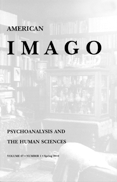This article includes a list of references, related reading, or external links, but its sources remain unclear because it lacks inline citations .(June 2025) |
This article needs additional citations for verification .(June 2025) |
 | |
| Discipline | Literature, psychology, social theory |
|---|---|
| Language | English |
| Edited by | Murray M. Schwartz |
| Publication details | |
| History | 1939–present |
| Publisher | |
| Frequency | Quarterly |
| Standard abbreviations | |
| ISO 4 | Am. Imago |
| Indexing | |
| ISSN | 0065-860X (print) 1085-7931 (web) |
| OCLC no. | 33418817 |
| Links | |
American Imago is an academic journal established in 1939 by Sigmund Freud and Hanns Sachs. It seeks to explore the role of psychoanalysis in contemporary cultural, literary, and social theory, while also considering issues related to anthropology, philosophy, politics, cultural studies, history, art history, musicology, education, and gender studies.
The current editor-in-chief of the journal is Jane Hanenberg. Past editors include Murray M. Schwartz, Louis Rose, Hanns Sachs, Harry Slochower, and George B. Wilbur. The journal is published by the Johns Hopkins University Press.